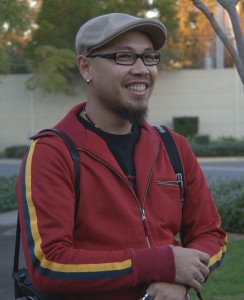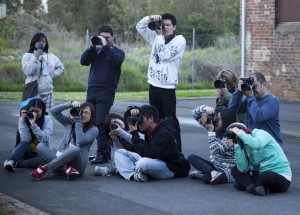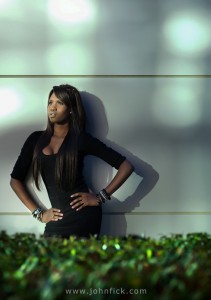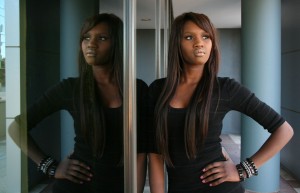Sydney-based photographer John Fick lives, eats and breathes light. If there’s one thing you’ll discover after attending one of his basic photography weekend workshops, it’s that good lighting trumps a good location everytime. MICHELLE BALTAZAR writes.
Only a month ago John Fick was working a dream job as a senior graphic designer for a top IT firm while spending some weekends as a sought-after wedding photographer.
But having juggled both passions for at least a decade, John told friends and family a couple of weeks ago that he quit his day job, starting a new chapter in his life as a full-time professional photographer.

Sydney-based photographer John Fick likes to crack jokes while teaching the techniques behind a good shot
Sydney-based photographer John Fick likes to crack jokes while teaching the techniques behind a good shot.
His boundless energy for photography was evident in the weekend workshop he held on July 17 at his residence in Stanhope Gardens. I signed up with the aim of at least learning what “aperture” meant but left knowing a lot more, including the language of light.
“You can have the best view in the world but if the lighting is bad, the photo will look flat,” he said.
“I can shoot a hallway full of garbage and make it beautiful. How? Good light.”
Over two days John described light as if it were a woman, or like a lover spurned one day then adored the next. If light wasn’t warm, luxurious or natural, it was flat, harsh or artificial.
Take, for instance, the time John points to a ray of light falling on just the right spot for a shot.
“This is my light. Pook, pook, pook [he said, mimicking the sound of a camera clicking away]. It’s beautiful light. Very honest light.”
John moved around with a photographic sixth sense. Like a metal detector that knows exactly where a gold nugget is, John knows where to place his subject to capture catchlights – those round specks of light on the eyes that can transform an ordinary shot into something extraordinary.
Day One: See the Light

Who's behind the camera? Course students capture the perfect shot of a model jumping mid-air.
Around a dozen eager shutterbugs, aged 16 to 40-plus, trekked their way to John’s house for the weekend. John started his workshop at 9am, which didn’t feel right for a Saturday morning but I guess that’s the first test: turn up early.
But once he opened the door, I knew I made the right choice. On the dining table was a collection of camera lenses that he invited us to check out and play around with. On the walls are picture frames and around the house are bric-a-brac, probably gifts from friends or things collected from their travels, all of which gave his place a warm and friendly vibe.
We all opened our little notebooks and wrote down what John told us about the art and science of photography. Our homework was to bring five photos and, in front of everyone, on a big screen, he looked at each of them.
To have someone critique your photos in front of strangers would have been a scary prospect but John handled it very well – giving us pointers on what’s good about the photos and what can be improved without tearing our fragile hearts into shreds. You could call it constructive criticism except it didn’t even feel like he’s judging our photos.
Next up was a showcase of his work to bring home his key message: yes, it’s all about the light. John said he used to be a purist (“I am in love with natural light”), meaning he doesn’t like using artificial light like the flash except when he’s doing studio work. But having been a photographer for at least a decade, he said he’s learnt to compromise and use technology when needed.
“Although I don’t use reflectors. They’re for amateurs. I’m really comfortable with using natural light,” he said.
After sitting through a basic course on the different types of light (“that’s warm light, that’s crispy light, that’s harsh light…”), John took us on a field trip, teaching us how to find lighting that will “make our pictures pop”.

John Fick takes a photo of model Isha to show how to take shots when there's "spotty light".
By the end of the day, John has completely changed my views about what makes a good photo. And after all those years of not knowing, do I now know when photos are overexposed, underexposed and how to fix them? Yes! Mission accomplished.
Day 2: From automatic to manual
Day Two started the same time as Day One: way too early! But fortune not only favours the brave, it also favours those who can set their alarm at 6am. One member of the group did beat me to it when she came knocking while John was still asleep.
He jokes, “You know how the early bird catches the worm. You’re not the bird, you’re the worm!”
It was classic Fick to slide in a joke here and there while he taught us the mechanics of photography. In what I could only describe as a miracle, John explained the concepts of depth of field, ISO and shutter speed in a way that made sense. “You don’t have to learn all the complicated stuff. Everything can be simplified.”
With the technical lesson out of the way and a hearty lunch of adobo and rice (and Filipino sweet desserts) in our tummies, John took us to our second and final field trip, this time at a park on Brickworks Drive near Parramatta. For the rest of the afternoon, John taught us how to combine the principles of good lighting with the principles of good composition.
He also encouraged us to engage our subject (the models he invited to the workshop) by talking more to them. He told us to experiment with location and the different poses that the model should do for each shot.
By 5pm it was time to pack up so we finished the workshop with some training on how to take good shots of people in motion, like when they’re walking or jumping.

My uncropped, unphotoshopped, totally untouched picture of Isha, one of the models.
The verdict
John Fick’s basic photography workshop gets a 10 out of 10. He managed to combine theory and practice in such a way that we all learnt the techniques of the trade and tested them out on the field.
The added bonus was his brief presentation on digital workflow and post-production where he explained how to save photos and use the Adobe Photoshop Lightroom program to enhance images.
His advice is to “practice, practice, practice”. The popularity of the digital camera means many people take an endless number of shots then discover a great shot only after the event.
“If you take the photos right the first time, you experience the moment as it happens, and that’s what photography is about, it’s about being in the moment.”
###
John is holding a one-day intensive photography workshop in Sydney on August 8. For more info, see www.johnfick.com or email him on [email protected]